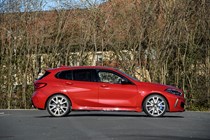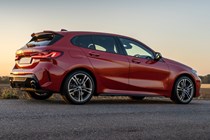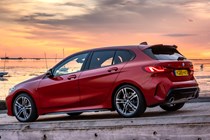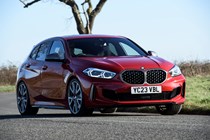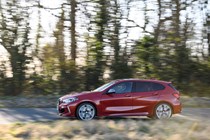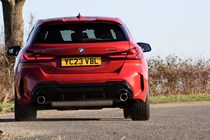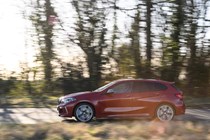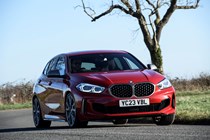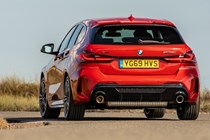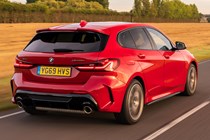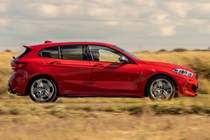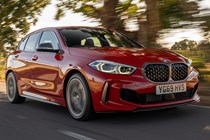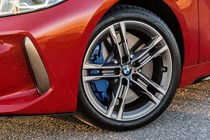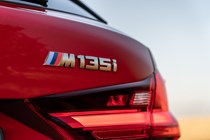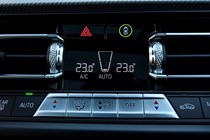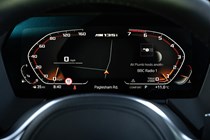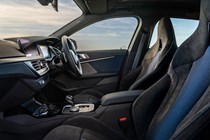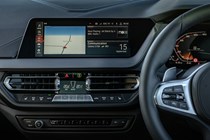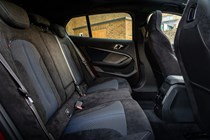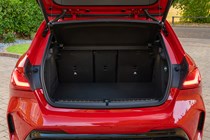
BMW 1-Series M135i (2019-2024) long-term test
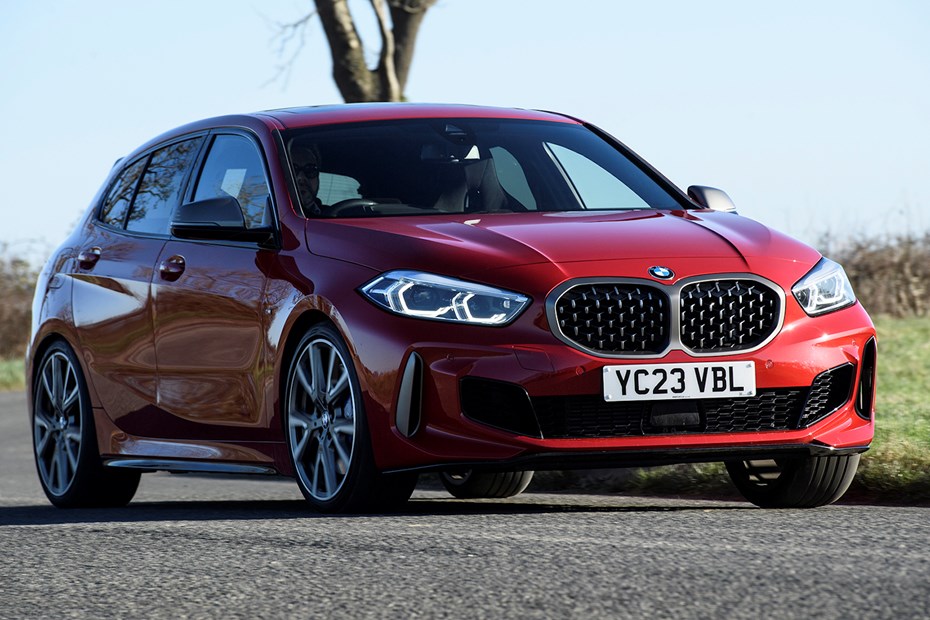
Mid-life crisis: as the hot-hatch approaches 50, is it time for boy racers to grow up? Gen-X Used car editor and former Ford Capri tamer, Richard Kilpatrick, ran BMW’s Gen-Z interpretation of a spicy family hatchback for three months…
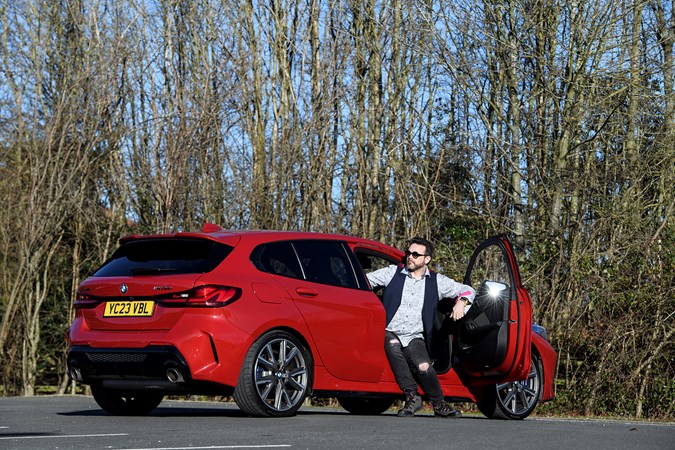
Jump to:
Update 1: Introduction to the 2023 BMW M135i xDrive
This is not the BMW I grew up with…
First rule of car journalism: check your data. When I was told I’d start the new year with a bright red F40 to drive it turns out that as well as being a famous Ferrari, F40 is the codename for BMW’s small FWD hatchback.
They share more than three characters though. Like 1988’s groundbreaking supercar, the BMW M135i can sprint from 0-60mph in under five seconds* – and unlike the F40, that performance is accessible regardless of driver ability.
Twenty years ago, when the 1 Series made its debut, I test drove the basic 116i. Basic was apt. For the price it seemed like terrible value, everything was optional. However, after getting comfortable on the test drive, the little RWD hatchback’s handling was very entertaining.
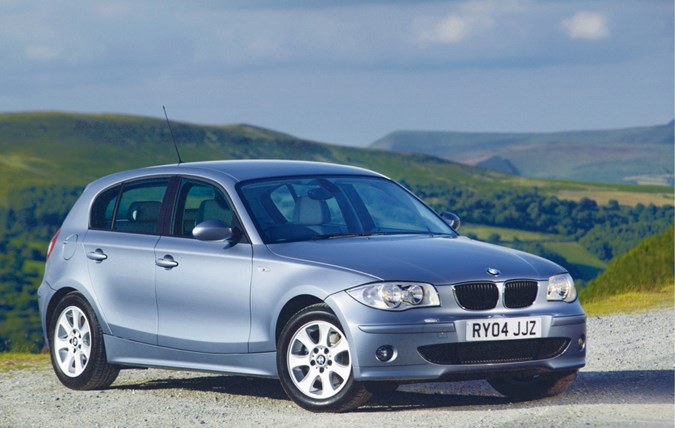
On familiar roads, the salesman was clearly doing his best through gritted teeth to let me enjoy myself. His composure collapsed when he asked what I thought, and I replied, ‘it’s like a Chevette’.
It wasn’t an insult. There is a lot to be said for having the lowest-power model of a nicely set up car, and my Chevette had been poked by rally mechanics in all departments except the tiny engine. Like the BMW, I could enjoy using all the revs and gears, and never really go fast enough to be antisocial on rural roads.
That new BMW was still too expensive for me though. Before the pandemic, leasing and PCP finance deals ensured plenty of variety in cars costing £250 per month.
Two decades later, the opportunity to thoroughly test the BMW M135i xDrive is very welcome. Not only do I get to tell you all about it, I also – finally – get to find out what living with a baby BMW is like, and discover how the makers of the Ultimate Driving Machine (TM) reconcile decades of rear-wheel drive devotion and experience with the pragmatism of making FWD hatchbacks (and small SUVs).
My BMW: Melbourne Red 2023 M135i xDrive with nearly £8,000 of options.
When I get a new test car, my first question is always ‘would I have chosen this and can I afford it?’. A little comparison-shopping reveals that the world of 300hp+ all-wheel-drive hot hatchbacks is surprisingly well catered for. There’s the Volkswagen Golf R, the Audi S3, and the Cupra Leon (it’s FWD, but if you choose the Leon Estate you can have AWD and a panoramic sunroof).
Our New cars editor, Alan, has just informed me that those are all the same car. It’s the Simpsons ‘bacon, ham, and pork’ moment all over again.
Away from VW Group there’s the Mercedes-AMG A35 4Matic, and of course, this BMW. The Honda Civic Type R is a tempting alternative but it costs more, and again, lacks the security of 4x4.
For a different balance of cost and performance, Toyota is bringing the rally-inspired GR Yaris back for another spin – albeit in limited numbers. It’s a much smaller car, and cheaper as well, but if the focus is on B-road fun and an authentic hot hatch experience it’s worth considering.
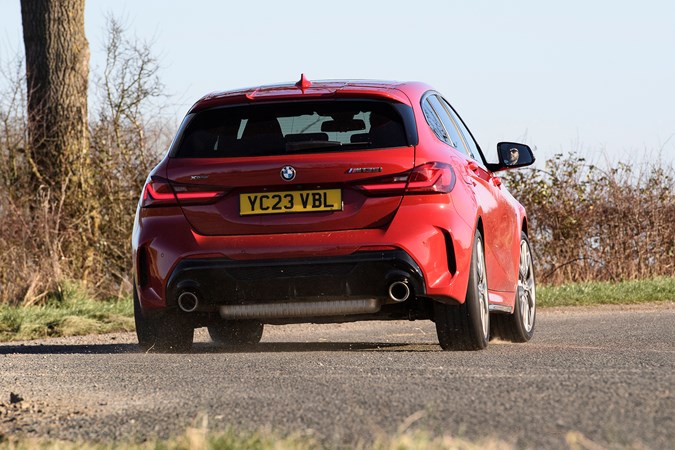
Nearly all of the alternatives cost as much before options as this fully-loaded BMW. I’ve highlighted the features that I actively want in each pack and listed them in order of personal appeal, but they represent good value and I’d find it hard to delete any one of them if trying to bring the cost down. Some rivals include a couple of these features as standard, but overall, the BMW M135i works out as the cheapest, or best-equipped for the same budget.
Option packs (in addition to £595 for Melbourne Red paint):
- Tech Pack, £1,575 – Adaptive LED headlights with high-beam assist, head up display, wireless charging with enhanced Bluetooth, WiFi hotspot, parking assistant
- Comfort Pack, £1,575 – heated seats and steering wheel, keyless entry, electric memory seats and a powered tailgate
- Pro Pack, £1,350 – this includes 19-inch wheels and sun protection glass, but of more interest to me is the Harmann Kardon sound system
Prices have changed slightly on these packs since my car was built, but not significantly – these are correct as of January 2024 and previously were £1,500 per pack, so the cost for all three remains the same.
If specifying the car myself, I’d take the individual options of Adaptive Suspension (£550, and not available with 19-inch wheels) and Harmann Kardon audio (£825), rather than the Pro Pack. It’s worth noting that adaptive cruise control isn’t currently available on the M135i, though it was part of the Driver Assistant pack if you find a nearly-new model with it. I’d also be happy with the no-cost option of Alpine White paint, though I’d want some BMW motorsport stickers to liven it up a bit.
Individual options:
- Panoramic sunroof, £1,100 – a must-have for me, not all rivals offer the option
- Split fold rear seat, £165
- Front lumbar support, £165 – weird that this is still an option
- Luggage Net, £165
After poring over the specs, prices, and general details of the alternatives, yes. I would choose the BMW. Could I afford it? At current lease and PCP deals, not really, but of the deals I could find at the time of writing, the M135i is cheaper than the Golf R, Audi S3 and Mercedes-AMG A35 by a considerable margin. It’s about the same as the Cupra Leon, but that doesn’t have four-wheel drive unless you choose the larger estate model.
A forgotten website has a bleak reminder of how much things have changed for car buyers, promoting a 2020 M135i lease offer for just £229 per month. You can double that now, and usually pay more deposit – yet the M135i is still more affordable than the £650-700 monthly cost of its rivals. I’ve seen offers with £479 deposit and £479 per month at 3.9% APR. Even in 2024 terms it looks like the BMW M135i is remarkably good value.
Is an approved-used BMW M135i xDrive worth considering?
In cash terms, a look at BMW’s approved-used stock suggests a low mileage, less than three year old M135i xDrive can be found for around £30,000. You’ll want to check which option packs are included of course. If you’re buying outright rather than financing, the cars have a good reputation for reliability and seem to age well, so it makes sense.
Finance is another matter – the PCP interest rate on used is 13.9%, the deposit needed is higher, and the monthly cost is more than the deals on a new M135i, with only a small reduction in the final payment (after 48 months you’ll pay £16,000 to keep a seven to eight year old, already second hand M135i, vs £20,000 to keep a four year old one you’ve owned from new).
As is so often the case, for finance buyers with the budget and credit rating to get a new car, the new car is undeniably the better deal.
Both used PCP, and new lease options, are out of my £250 monthly budget these days. Four years ago the M135i would have been within reach and very tempting – I’m getting a taste of what could have been. First impressions are good. I like the interior, the style is subtle, there are physical controls for everything and it’s easy to get the perfect driving position.
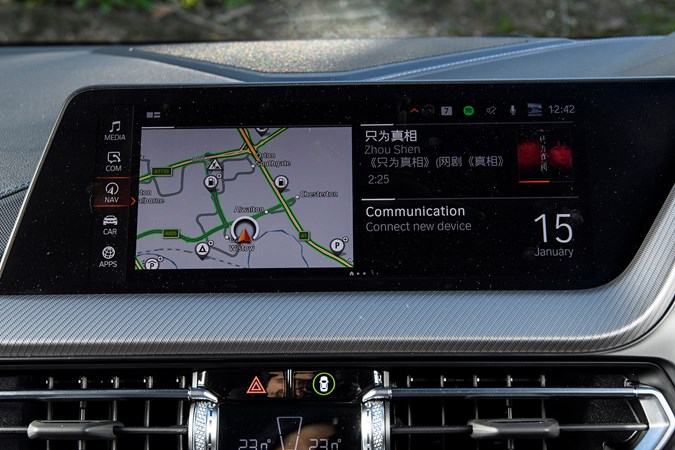
After a couple of hours playing with BMW’s ConnectedDrive system (including the smartphone app, iDrive infotainment and user registration), you can see where BMW’s reputation and image as part of a busy professional lifestyle comes from. The tech experience is so polished that I can ask Alexa in the kitchen to warm up the interior for me, and iDrive can stream Spotify even when I don’t have my phone. It took very little time to set up, ‘just works’, and I’m impressed.
I can’t wait to see if the driving experience is equally complete and competent.
Update 2: at home in the M135i
The BMW’s done as many miles since January as it had since first registration – it’s becoming a familiar place to be
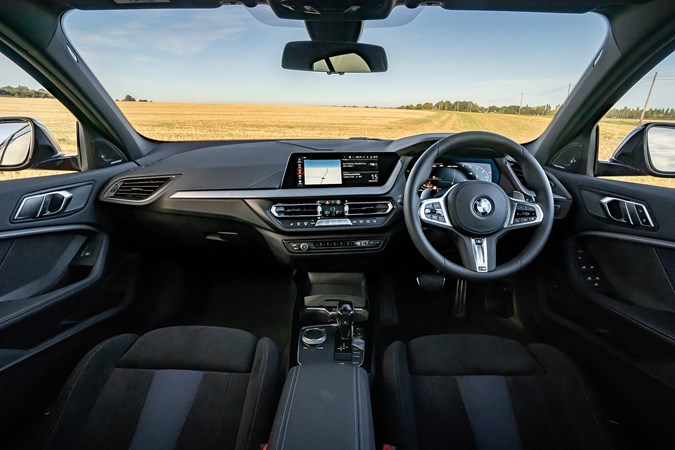
This is a driver’s car – by which I mean the focus isn’t just a case of appealing to someone who enjoys driving. In the modern era of SUVs and big family cars, a smallish, low hatchback is a compromise for passengers, and sitting low down is also a perfect vantage point to enjoy the downside of van and aftermarket LED headlights. You have to want the benefits of four-wheel drive, firm suspension and ample power-to-weight to pick this over an X1, X2 or even a 2 Series Active Tourer.
I do want those benefits. The mileage covered suggests that the M135i has become second-nature, and it has – the seats are comfortable for long drives, the instruments – well, the head up display – clear and easy to read, and everything just works. Even the Alexa-enabled skills to check the car’s status.

There are plenty of hardware controls, essentially one button every feature, and they’re tactile and easy to find by hand without looking. Most of the time, features like the heated steering wheel are active when I want and off when I don’t anyway, without having to find a control. I’ll miss iDrive though – a feature rumoured to be departing with the facelift.
Acclimating to the hot-hatch vibe
Like the cabin, the firm ride is becoming more familiar to my instincts and I’m less concerned by road imperfections. Yes, Britain’s tarmac is in a terrible state, and yes, the 1 Series feels WIDE on a B-road, but so far (and long may it remain thus) the teeth-jarring thud of an unavoidable pothole has not damaged a tyre, so perhaps it is just how it transmits that feeling. Reinforcing that suspicion, my classic Range Rover – all off-road tyres and massive springs – is just as spine-shattering on the same roads. More so, as the steering kicks so you tense up.
With trust comes confidence, so the M135i has been deployed for my favourite missions. Collecting a massive load of old Apple IIs from Cheshire, there is no route that avoids Peak District villages without doubling the distance. Relax, accept the 50mph average cameras are just life, and embrace what the M135i can do.
One: it can climb the Cat and Fiddle sections absolutely brilliantly without breaking the speed limit, but feeling heroically quick all the same. The grip from the xDrive system plays a big part in this, but there’s a pleasing lack of understeer as well. The adaptive lights don’t offer front fog lights, but the searchlight-sweep is amusing.
Two: with the seats down, it’s bigger than it looks. And there’s space under the boot floor as well.
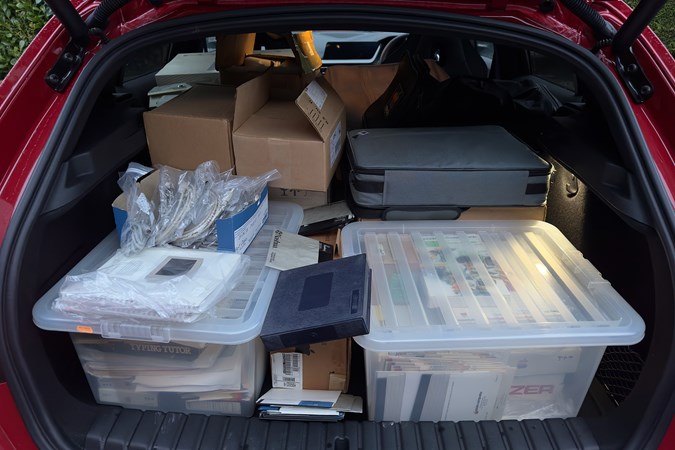
Thanks to some grotty weather and lots of miles devoured in cold and rain, the car’s filthy. I’m kind of proud about that after the isolation of lockdown – and knowing a lot of that salt spray was earned enjoying some of Britain’s most beloved Peak District routes despite the realities of congestion, bigger cars, and potholes…
Update 3: economy, tyres and time out
Most aspects of the M135i are really impressive. Except for one tiny, insignificant little detail that leaves a lapsed scout feeling very unprepared
Time to rip that motoring skills badge off my old scout uniform. My previous update mentions two things – potholes, and ‘space under the boot floor’. You’ve guessed it – fate was reading, and on a dark, damp night I went under a narrow Derbyshire bridge and found not a troll, but a double-wide long pothole from an HGV’s emergency stop lurking in the shadows. There wasn’t much room to avoid it – and a couple of days later, it was filled. I wonder if it’s worth trying to claim for pothole damage.
In some ways, I’m lucky – not going fast, and on a relatively quiet route, I was spared the humiliating defeat of cracked or damaged alloys after taking so much care with parking to avoid kerbing them. But it was a sharp, square edged one and quite deep – two punctures result.
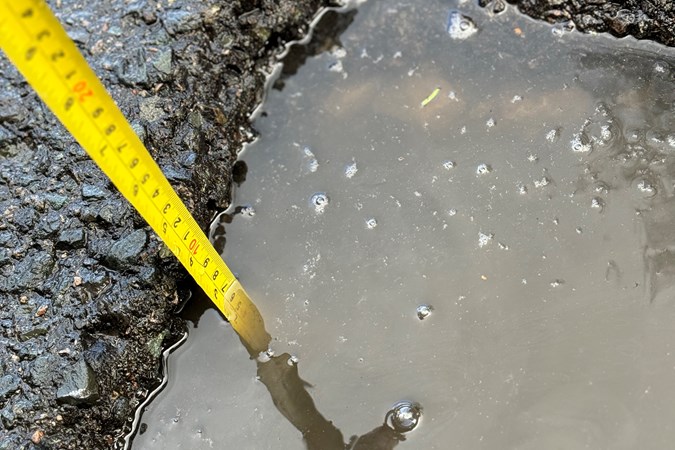
The space under the boot floor is because this car has no spare tyre, just the tirefit kit, and it’s not running on BMW’s optional run-flat tyres. The dashboard tyre pressure display showed the rate at which the tyres were deflating – fortunately, there was enough air remaining to get to a safe place, inflate a little more, and get home, but then I had to work out how to get new tyres.
Inspecting for damage after a pothole
The lack of spare means there’s also no factory jack or wheelbrace. As it happens I do have tools for fixing old cars, but my jack doesn’t go low enough to clear the M135i’s sills. Fitted with Bridgestone Potenza S005s in 235/35/19 Y91 fit I feared the worst for the bill, but they’re quite reasonably priced at around £150-170 per tyre.
To find out if tyres would be all that was needed, I used a battery-powered compressor and washed the wheels with soapy water on both inside and outside edges. This doesn’t help locate punctures in the tread, but if there is sidewall damage (which cannot be repaired) it locates where the impact was making it easier to focus on that area of the wheel. A visual check suggested no damage, but feeling for imperfections is more likely to reveal a buckled rim.
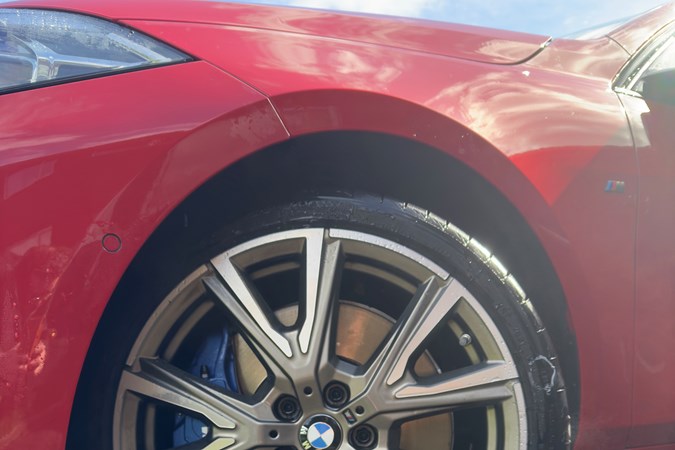
As this was low-speed I felt confident the risk of damage to the hub or suspension was low, but until the wheels are fitted with new tyres and re-balanced nothing can be taken for granted. This could easily have been much worse and while visiting the location during daylight to take pictures, the number of near-missed head-on collisions due to drivers trying to dodge the pothole and leaking water potentially obscuring more holes near the kerb highlights just how dangerous Britain’s neglected roads can be, rather than merely inconvenient or uncomfortable.
Tirefit – does it work?
To get the tyres, I had to drive to the workshop – so with the comfort of not being on a dark, wet, dangerous roadside, surely the emergency repair goo would be a pleasant experience? No. There is only enough in the bottle for one wheel, and the nature of the puncture meant it mostly just sprayed back out of the tyre. I recommend buying some of the third-party emergency canisters – or, with a newer car like this, just using the manufacturer’s emergency service.
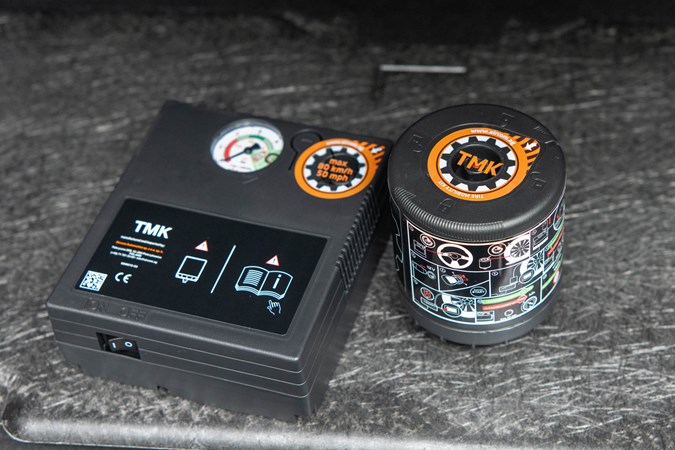
When the tyre was removed the goo was still liquid. Fortunately this made cleaning the 19-inch alloys fairly easy. It’s not pleasant stuff, and I recommend buying some disposable gloves to keep in the car with the kit.
If it weren’t for the very accurate tyre pressure and temperature monitors I’d have been unable to drive the car safely and would have risked damaging the wheels doing so – unfortunately no mobile services were available with the same brand and pattern of tyre.
Do BMW xDrive cars need four tyres at once?
In every used car buying guide I write for an all-wheel drive model, you’ll see a reference to tyres and service history. A two-wheel drive car has a differential to cope with the different rolling speeds of wheels on the same axle, and an open differential can let a single wheel spin and the other stay still. Four wheel drive cars usually have open differentials at each end, but the centre differential is usually designed to have some resistance – viscous coupling models use the difference in speed front to rear to heat up oil that engages a more even split of torque front to rear, for example.
But this is only supposed to happen for short times. Different sizes of wheel mean different speeds constantly and when they all have grip, the all-wheel drive system is constantly under an unbalanced load it wants to correct.
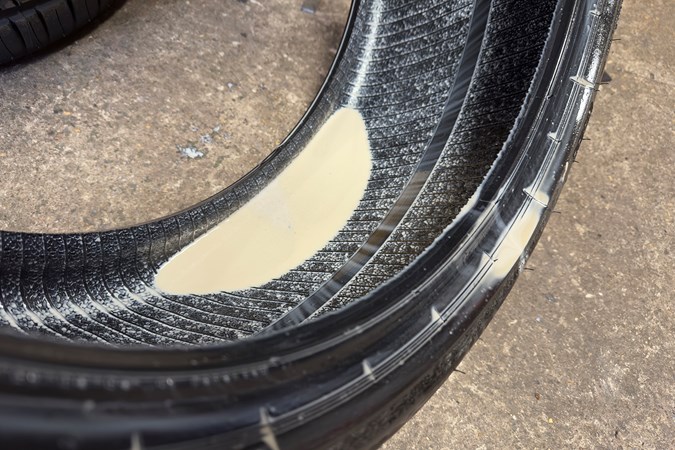
Just-Tyres’ Chesterfield branch were very quick to point out I’d only ordered two tyres for an xDrive, and had lots of posters explaining the problem of four-wheel drive cars and part-worn tyres – which I find very reassuring. It naturally feels like an upsell tactic, but BMW’s own specification says no more than 3mm tread difference between tyres.
BMW M135i xDrive running cost – consumables
With less than 4,000 miles on my car, how much tread has been used? My front tyres had 4mm, my rear tyres, 5.5mm. New tyres have 7.7mm. This suggests that tyre rotation matters – though the tyre shop told me the tyre pressure sensors are coded to the corner of the car and didn’t fit both new tyres on the front.
It also suggests that a BMW M135i xDrive might need a new set of tyres every 12-15,000 miles at a cost of £600-800 (depending on brand and applicable offers). The tyre sealant is under £30 for a new genuine BMW bottle – and some breakdown services can be difficult if you don’t have the kit. (Some will consider a two-puncture pothole an accident and refuse to attend, or charge for doing so).
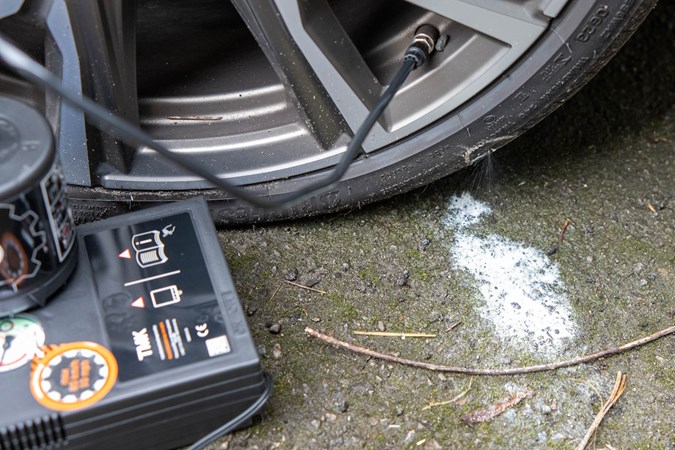
It could be that the car has more wear due to being used for tests, but I’ve covered more than half of the total miles now with gentle road driving. The BMW app is happily reporting I’m getting better economy than 46% of other M135i drivers. The best trip is 39.1mpg – but reassuringly, the overall average is over 31mpg now, and I do end up with a fair number of short trips while being fond of the ‘Sport’ button. Next month I’ll try to stick to Eco…
| 2023 BMW M135i xDrive long-term test | 2024 test data |
|---|---|
| Date registered / mileage on delivery | 1 March 2023 / 1,799 |
| Test miles covered / car mileage | 2,008 / 3,807 |
| Average fuel economy | 31.9mpg |
| Parkers ‘MPP’ (Miles Per Pound) calculation | 5.2 – 5.6 |
| Car joined Parkers fleet | January 2024 |
| Value new with options | £45,704.99 |
| Approved-used retail price at time of test | £35,295 |
*The first F40 test published achieved 0-62mph in 4.7 seconds, compared with 4.8 seconds for the M135i, but subsequent tests and improvements to the car pushed those results below 4.1 seconds. Ferrari doesn’t give official figures.




